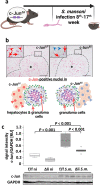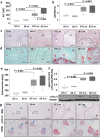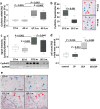Hepatocyte integrity depends on c-Jun-controlled proliferation in Schistosoma mansoni infected mice
- PMID: 37990129
- PMCID: PMC10663609
- DOI: 10.1038/s41598-023-47646-z
Hepatocyte integrity depends on c-Jun-controlled proliferation in Schistosoma mansoni infected mice
Abstract
Schistosomiasis is a parasitic disease affecting more than 250 million people worldwide. The transcription factor c-Jun, which is induced in S. mansoni infection-associated liver disease, can promote hepatocyte survival but can also trigger hepatocellular carcinogenesis. We aimed to analyze the hepatic role of c-Jun following S. mansoni infection. We adopted a hepatocyte-specific c-Jun knockout mouse model (Alb-Cre/c-Jun loxP) and analyzed liver tissue and serum samples by quantitative real-time PCR array, western blotting, immunohistochemistry, hydroxyproline quantification, and functional analyses. Hepatocyte-specific c-Jun knockout (c-JunΔli) was confirmed by immunohistochemistry and western blotting. Infection with S. mansoni induced elevated aminotransferase-serum levels in c-JunΔli mice. Of note, hepatic Cyclin D1 expression was induced in infected c-Junf/f control mice but to a lower extent in c-JunΔli mice. S. mansoni soluble egg antigen-induced proliferation in a human hepatoma cell line was diminished by inhibition of c-Jun signaling. Markers for apoptosis, oxidative stress, ER stress, inflammation, autophagy, DNA-damage, and fibrosis were not altered in S. mansoni infected c-JunΔli mice compared to infected c-Junf/f controls. Enhanced liver damage in c-JunΔli mice suggested a protective role of c-Jun. A reduced Cyclin D1 expression and reduced hepatic regeneration could be the reason. In addition, it seems likely that the trends in pathological changes in c-JunΔli mice cumulatively led to a loss of the protective potential being responsible for the increased hepatocyte damage and loss of regenerative ability.
© 2023. The Author(s).
Conflict of interest statement
The authors declare no competing interests.
Figures






Similar articles
-
Pharmacological Inhibition of c-Jun N-Terminal Kinase Activity Exacerbates Liver Damage in Schistosoma mansoni Infected Mice.Liver Int. 2025 Sep;45(9):e70260. doi: 10.1111/liv.70260. Liver Int. 2025. PMID: 40751475 Free PMC article.
-
Schistosoma mansoni Egg-Secreted Antigens Activate Hepatocellular Carcinoma-Associated Transcription Factors c-Jun and STAT3 in Hamster and Human Hepatocytes.Hepatology. 2020 Aug;72(2):626-641. doi: 10.1002/hep.30192. Epub 2019 Feb 12. Hepatology. 2020. PMID: 30053321 Free PMC article.
-
Liver Fibrosis Is Enhanced by a Higher Egg Burden in Younger Mice Infected with S. mansoni.Cells. 2024 Oct 2;13(19):1643. doi: 10.3390/cells13191643. Cells. 2024. PMID: 39404406 Free PMC article.
-
c-Jun/AP-1 controls liver regeneration by repressing p53/p21 and p38 MAPK activity.Genes Dev. 2006 Aug 15;20(16):2306-14. doi: 10.1101/gad.390506. Genes Dev. 2006. PMID: 16912279 Free PMC article.
-
Expression of c-jun is not mandatory for mouse hepatocyte proliferation induced by two nuclear receptor ligands: TCPOBOP and T3.J Hepatol. 2011 Nov;55(5):1069-78. doi: 10.1016/j.jhep.2011.02.016. Epub 2011 Feb 25. J Hepatol. 2011. PMID: 21354444
Cited by
-
The antifibrotic effect of Vildagliptin and Diaminodiphenyl Sulfone in murine schistosomiasis mansoni.Sci Rep. 2025 Mar 24;15(1):10084. doi: 10.1038/s41598-025-91955-4. Sci Rep. 2025. PMID: 40128243 Free PMC article.
-
Pharmacological Inhibition of c-Jun N-Terminal Kinase Activity Exacerbates Liver Damage in Schistosoma mansoni Infected Mice.Liver Int. 2025 Sep;45(9):e70260. doi: 10.1111/liv.70260. Liver Int. 2025. PMID: 40751475 Free PMC article.
References
-
- WHO. Schistosomiasis Fact Sheet, 02_2023; Available from: https://www.who.int/news-room/fact-sheets/detail/schistosomiasis.
-
- Salas-Coronas J, Bargues MD, Lozano-Serrano AB, Artigas P, Martínez-Ortí A, Mas-Coma S, et al. Evidence of autochthonous transmission of urinary schistosomiasis in Almeria (southeast Spain): An outbreak analysis. Travel Med. Infect. Dis. 2021;44:102165. doi: 10.1016/j.tmaid.2021.102165. - DOI - PubMed
MeSH terms
Substances
Grants and funding
LinkOut - more resources
Full Text Sources
Molecular Biology Databases
Research Materials
Miscellaneous

